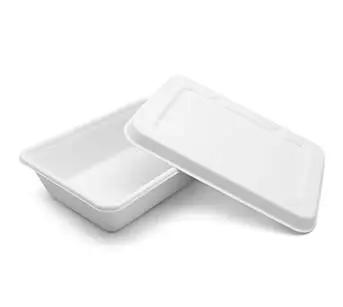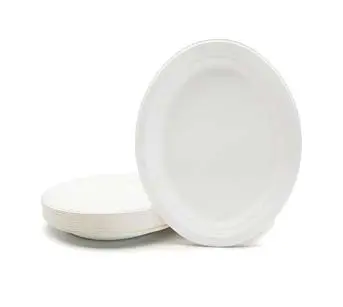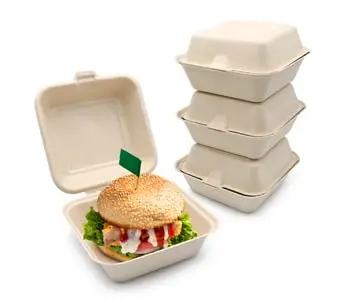Bagasse trays have emerged as a sustainable and eco-friendly alternative to traditional food service trays made from plastic or Styrofoam. These trays are crafted from bagasse, a fibrous byproduct obtained from the extraction of sugarcane juice.
Bagasse trays not only offer functional advantages but also contribute to reducing environmental impact in various ways. In this comprehensive article, we will explore the properties and numerous advantages of bagasse trays, shedding light on their growing popularity in the food industry.
Definition of Bagasse Trays
Bagasse trays are biodegradable disposable containers that serve as an appealing solution for food packaging and presentation. They are created using bagasse, which refers to the residue material left after sugar has been extracted from sugarcane or other plant sources such as wheat straw. Bagasse is a fibrous substance primarily composed of cellulose, hemicellulose, and lignin. The manufacturing process involves transforming this natural plant waste into a pulp-like substance, which is then molded into various tray designs using heat and pressure. These trays can be found in a diverse range of sizes and shapes to accommodate different culinary needs.
Brief History and Origin of Bagasse Trays
The history of bagasse trays dates back several decades when researchers began exploring sustainable alternatives to replace non-biodegradable materials commonly used in food packaging. The concept gained traction due to concerns about the environmental impact caused by the excessive use of plastic and Styrofoam products.
Sugarcane-producing regions became particularly interested in utilizing bagasse since it was readily available as an agricultural waste product generated during sugar production processes. This marked the birth of bagasse trays as an innovative solution for reducing waste while providing practical functionality.
The origin can be traced back to countries like India, Brazil, and Thailand, where sugarcane cultivation is prevalent. These regions recognized the potential of bagasse trays in supporting sustainable agricultural practices and reducing the carbon footprint associated with food packaging.
Material Composition
Bagasse trays are crafted from bagasse, a natural byproduct of sugarcane or wheat straw processing. Derived from the fibrous residue that remains after extracting juice from these crops, bagasse is an abundant and renewable resource. Sugarcane bagasse is particularly popular due to its high cellulose content, making it an ideal material for crafting biodegradable and compostable trays.
The fibrous nature of bagasse contributes to its exceptional strength and durability. Bagasse consists of three main components: cellulose, hemicellulose, and lignin.
Cellulose forms the structural backbone of plants and is responsible for the tray's rigidity. Hemicellulose acts as a bonding agent between cellulose fibers, enhancing the tray's cohesive properties.
Lignin provides additional rigidity and water resistance. Furthermore, one of the remarkable properties of bagasse trays lies in their biodegradability and compostability.
When discarded, these trays break down naturally over time without leaving behind harmful residues or polluting the environment. They can be composted along with organic waste to enrich soil quality.
Strength and Durability
While being environmentally friendly, bagasse trays also possess remarkable strength and durability. Their mechanical properties make them suitable for various applications in food service industries. In terms of tensile strength, bagasse trays exhibit impressive resistance to deformation under applied stress or pressure.
This enables them to withstand heavy loads without compromising their structural integrity or risking food spillage. In addition to mechanical strength, these trays offer excellent heat resistance and insulation properties.
They can endure high temperatures without warping or softening when used in ovens or microwaves within specified temperature limits. Moreover, their insulation characteristics help keep food warm while preventing excessive heat transfer to the user's hands.
Water resistance is another notable feature of bagasse trays. The fibrous composition of bagasse, combined with lignin's hydrophobic properties, creates a natural barrier against moisture.
This makes bagasse trays a reliable choice for serving both hot and cold foods without concerns of sogginess or leakage. Furthermore, these trays showcase oil resistance, preventing greasy foods from seeping through and maintaining their structural integrity.
Size and Shape Versatility
The moldability of bagasse allows for the creation of trays in various shapes and sizes to cater to diverse food service needs and preferences. Bagasse trays can be molded into different designs, such as rectangular, round, or compartmentalized configurations.
This versatility enables easy packaging of meals with separate compartments for main dishes, sides, or sauces. By accommodating multiple food items in one tray without mixing them together, these designs enhance convenience and maintain food presentation.
Moreover, bagasse trays offer customizable dimensions to meet specific requirements. Manufacturers can produce trays in varying lengths, widths, and depths according to the desired capacity or portion-sized servings needed by businesses.
This flexibility makes bagasse trays adaptable for use in restaurants, cafeterias, catering services, or even for individual consumption at home. By leveraging the natural properties of bagasse material coupled with its moldability options and durability aspects like heat resistance and water resistance emphasized above - these eco-friendly tray alternatives provide a viable solution that combines sustainability with functionality in the ever-growing food industry landscape.
Advantages of Bagasse Trays
Environmental sustainability - Embracing a greener alternative
Bagasse trays offer a remarkable advantage over conventional plastic or Styrofoam trays by providing an eco-friendly alternative that helps combat the escalating environmental concerns. Unlike their synthetic counterparts, bagasse trays are made from 100% natural and renewable resources. As they are derived from agricultural waste, primarily sugarcane or wheat straw, these trays contribute to reducing landfill waste.
By utilizing and transforming this abundant agricultural byproduct into functional food containers, bagasse trays effectively mitigate the burden on landfills, which would otherwise be inundated with plastic or Styrofoam waste. Embracing these biodegradable and compostable trays is a significant step towards achieving sustainable living practices.
Moreover, the production of bagasse trays helps in conserving natural resources. By utilizing agricultural waste that would otherwise go unused or be discarded, we tap into a valuable resource stream while minimizing the need for virgin materials.
This approach lessens the demand for traditional paper products made from trees or other non-renewable sources. Bagasse trays showcase how ingenuity and resourcefulness can come together to create practical and sustainable solutions that benefit both our environment and our communities.
Economic benefits - A win-win situation
Bagasse trays not only offer environmental advantages but also present compelling economic benefits for businesses worldwide. One significant advantage lies in their cost-effective production process driven by the abundance of raw materials available from sugarcane or wheat straw crops. These crops are often grown specifically for sugar production, leaving behind ample quantities of bagasse as waste material waiting to be repurposed.
Additionally, promoting local agriculture is another positive outcome associated with bagasse tray production. Utilizing sugarcane or wheat straw waste not only reduces carbon emissions associated with long-distance transportation but also supports regional farmers by creating a market for their byproducts.
This not only strengthens the local economy but also fosters a sense of community as businesses collaborate with farmers to develop sustainable solutions. Furthermore, bagasse trays offer the potential for revenue generation through recycling programs.
As these trays are biodegradable and compostable, they can be collected from consumers and processed into organic matter or biofuel. Establishing effective recycling systems around bagasse trays creates opportunities for waste management companies to generate additional revenue while supporting a circular economy that encourages responsible resource utilization.
Functionality and versatility - The perfect balance
Bagasse trays strike an impeccable balance between functionality and versatility, making them an ideal choice for various food service applications. Despite their lightweight nature, these trays exhibit impressive sturdiness that ensures ease of handling without compromising durability. Their robust construction allows them to withstand the weight of different food items without any risk of deformation or breakage, ensuring a reliable serving option for both businesses and consumers alike.
Furthermore, bagasse trays offer convenience in terms of heating food items. They are microwave-safe and oven-safe up to a certain temperature range, providing flexibility when it comes to reheating meals or keeping them warm for longer periods without losing structural integrity.
This feature adds value to bagasse trays as they seamlessly fit into modern culinary practices while catering to diverse consumer needs. Bagasse trays demonstrate compatibility with various types of food – be it hot or cold dishes.
Their inherent insulation properties help in maintaining desired temperatures while ensuring no adverse impact on taste or quality. From piping hot soups and curries to refreshing salads and desserts, the versatility of these trays shines through by accommodating different culinary delights without sacrificing performance.
Aesthetic appeal - Beauty meets practicality
In addition to their functional attributes, bagasse trays possess an aesthetic appeal that enhances the overall dining experience. Their natural fibrous texture adds visual interest to the presentation of meals, lending an organic and earthy touch to the dining setting. This subtle yet distinctive aesthetic quality makes bagasse trays an ideal choice for various occasions, from casual outdoor picnics to elegant events, where they effortlessly merge beauty with practicality.
As we delve into the properties and advantages of bagasse trays, it becomes evident that they are more than just disposable food containers. These trays represent a significant stride towards addressing environmental concerns by offering an eco-friendly alternative to plastic or Styrofoam trays. Through their biodegradability, they actively contribute to reducing landfill waste and conserving natural resources by repurposing agricultural byproducts.
Beyond their environmental impact, sugarcane bagasse tray offers economic benefits through cost-effective production processes and support for local agriculture. Their functional versatility and aesthetic appeal make them a well-rounded choice for food service applications across the globe.
By choosing bagasse trays over conventional alternatives, we propel sustainable practices forward while enjoying the benefits of enhanced functionality and visual appeal. In embracing bagasse trays as a conscious choice in our daily lives, we pave the way for a greener future where practicality meets sustainability without compromising on style or efficiency.




